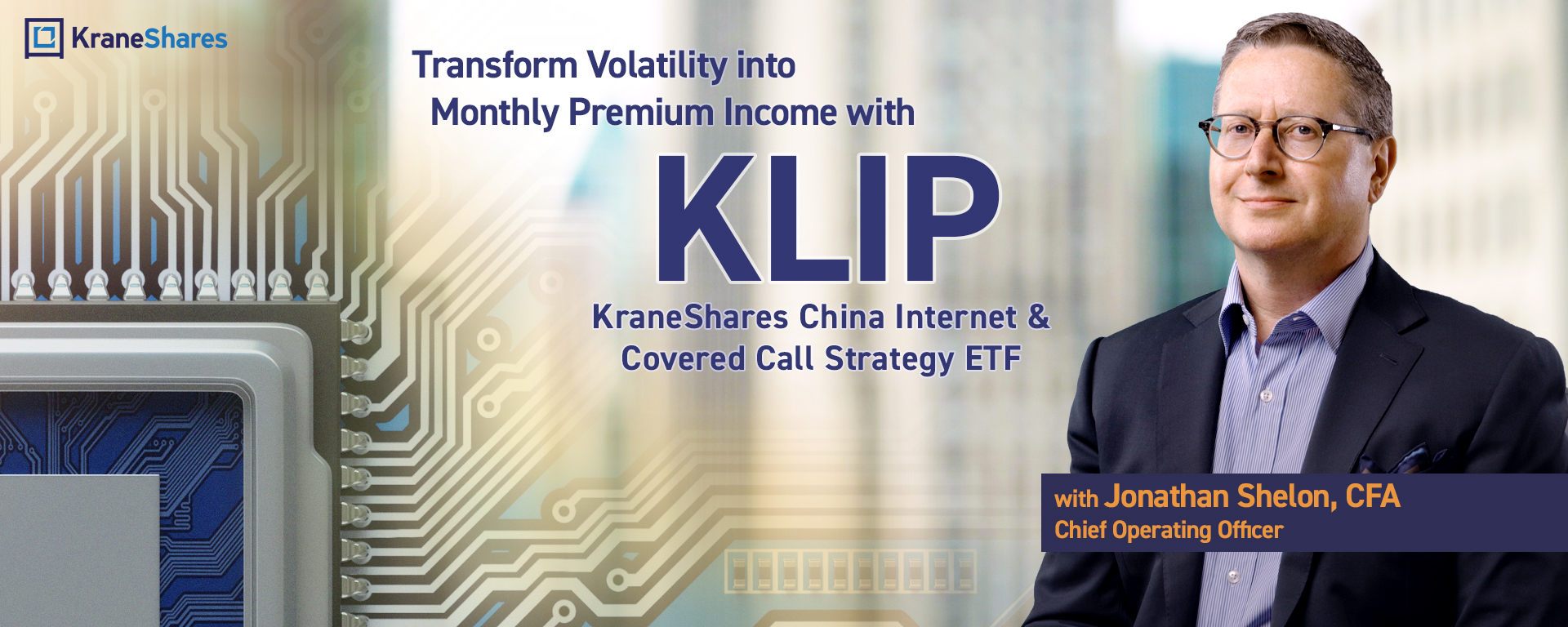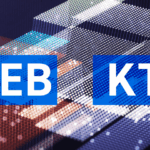
Transform Volatility into Monthly Premium Income with KLIP
Transcript
Hi, I'm Jonathan Shelon, Chief Operating Officer at KraneShares. We're here today to talk about our China Internet and Covered Call Strategy ETF: KLIP, ticker K-L-I-P.
KWEB and Opportunity in China's Internet Evolution
China's got the world's second largest economy, and it's one of the fastest growing economies amongst the large countries. And it's driven by the fact that China's rapidly growing middle class is really a consumer-based middle class. In fact, about a third of China's retail sales happen online.
KWEB invests in about 30 to 40 stocks, which are some of the online and e-commerce leaders in China—companies like Alibaba and Tencent and Meituan and Pinduoduo—and they really reflect China's future growth potential.
What makes KWEB stand out from other ETFs?
KWEB has become a popular option for investors to capture China's growth and has grown to be a fairly large ETF, about $5 billion.1 And what's also happened alongside KWEB’s growth is a well-developed options market, which also represents billions of dollars, making KWEB a Top 30 Optionable ETF.2
What is a covered call ETF?
Options-based ETFs have democratized what has historically been a fairly sophisticated strategy and not one accessible to everybody. A covered call strategy allows an investor to sell call options on an underlying investment and generate premium income over time. The benefit of a covered call strategy is that you can substitute uncertain upside from an investment with a more stable stream of premium income that pays out every time you write the call option.
We did a lot of research last year and noticed that the covered call space has grown rapidly to well over $45 billion now.3 As part of our R&D process, as we were developing KLIP, we realized that we could invest directly in KWEB and write covered calls on those shares and generate a higher income opportunity than what was traditionally available in the marketplace.
Putting Volatility to Work in China's Internet Sector
KWEB's volatility tends to be higher than other popular indexes. For example, when we look historically at the relationship between KWEB volatility and the S&P 500 or the Nasdaq, it is 2 to 4 times more volatile.4 Because of KWEB’s heightened volatility, we've been able to write options on KWEB, producing 4 to 5% premium income per month. This means that over a period of 12 months, we have a current distribution rate that's between 50 and 55%.
For KLIP standard performance, top 10 holdings, risks, and other fund information, please click here.
What makes KLIP unique is that we have the ability to pair KWEB with the covered call options themselves. When we looked across the entire covered call landscape, a lot of ETFs are not able to do that. So this is a really unique feature that makes our strategy more straightforward and transparent.
Targeted Growth and Income Strategy with KLIP & KWEB
We've built KLIP to be a strong complement to KWEB, with KWEB representing 100% growth potential, KLIP represents 100% income potential. Adding an income-producing strategy like KLIP can help an investor manage volatility. Both KLIP and KWEB can be used together. While investors appreciate the upside potential that KWEB can offer, they also recognize the uncertainty and the volatility. So one way of dampening some of that volatility is combining KWEB and KLIP together in a single portfolio.
Please visit KraneShares.com to learn more about KWEB and KLIP, and for real-time updates on what's happening in China, please subscribe to ChinaLastNight.com. Thank you for watching.
This material must be preceded or accompanied by a current prospectus. Investors should read it carefully before investing or sending.
For KWEB standard performance, top 10 holdings, risks, and other fund information, please click here.
This material contains Jonathan Shelon's opinion. It should not be regarded as investment advice or a recommendation of specific securities. Holdings are subject to change. Securities mentioned do not make up the entire portfolio and, in the aggregate, may represent a small percentage of the fund.
Citations:
- Data from KraneShares as of 6/30/2023.
- Data from Bloomberg as of 6/30/2023.
- Data from Volos as of 12/31/2022. Retrieved 6/30/2023.
- Data from Bloomberg as of 8/1/2021-3/31/2023.
Definitions:
The Monthly Distribution is the amount paid out by the fund as a distribution expressed as a percentage of the fund’s NAV as of the market close on the day prior to the ex-date. Distribution levels may vary month-to-month and no minimum distribution amount can be guaranteed.
The Distribution Rate is the annualized payout, expressed as a percentage of NAV, that an investor would receive, assuming that the latest monthly distribution remained the same over the next twelve (12) months. Distribution Rate may include return of capital, ordinary dividends, or capital gain. Distributions may coincide with a decline in NAV. The Distribution Rate is representative of a single distribution and does not indicate total return. Future distributions may differ significantly from the latest distribution and are not guaranteed. Through 9/30/2023, it is estimated that 100% of the Fund’s distributions have been return of capital. Actual sources of the distributions may vary at the end of the year, and will be provided in Form 1099-DIV.
30-day SEC Yield is a standardized yield calculation used to compare the yield of mutual funds, exchange-traded funds (ETFs), and other investment options. It represents the yield an investor would receive in the form of interest or dividends over the course of a 30-day period, assuming that dividends and interest are reinvested.










